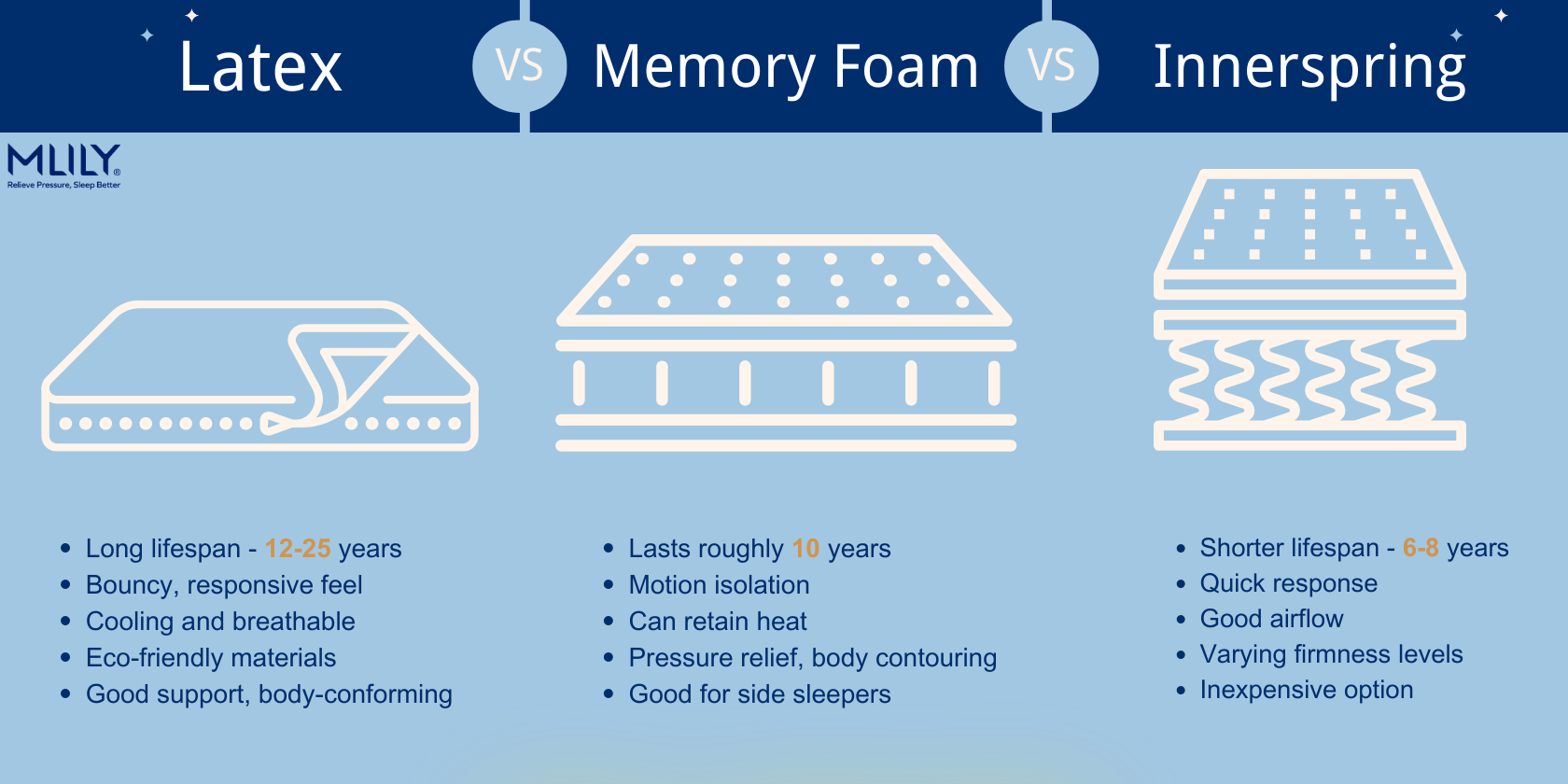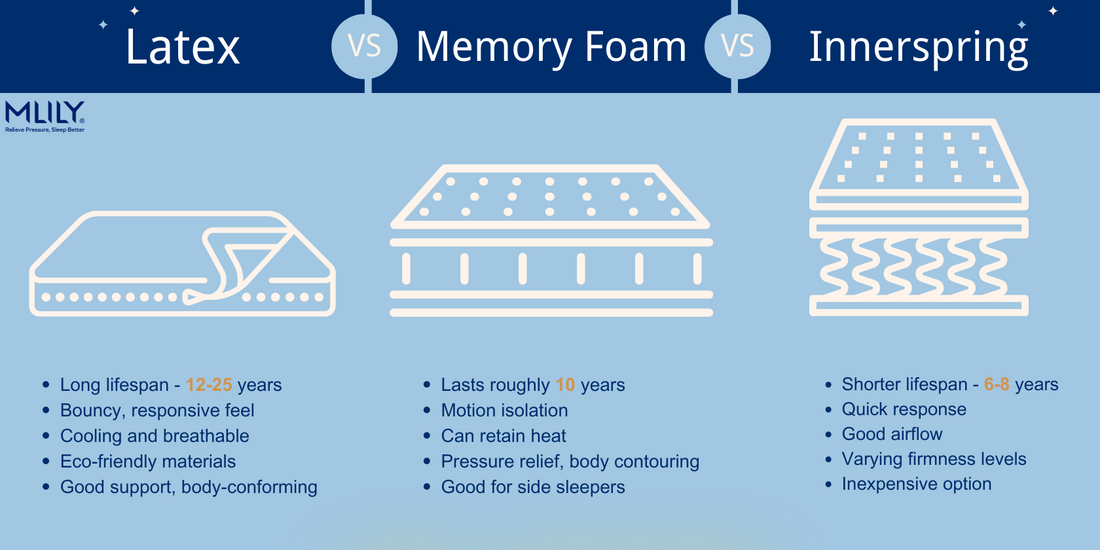
While most mattresses tend to hold up anywhere from roughly 6 to 10 years, there are many factors that play into the lifespan of any mattress. Aspects such as material and manufacturing quality, firmness, and environment can all affect how long a mattress will last.
The Lifespan of a Mattress
From an overall standpoint, most quality mattresses need to be replaced roughly every 6 to 8 years. Of course, with numerous factors involved in this estimate, it’s bound to vary from one person to the next.
Aspects such as material and manufacturing quality, environment, personal care, and many other elements can play into the total lifespan of a mattress. In the following sections, you’ll get a look at varying lifespans for different types of mattresses and the leading factors in how fast they age.
1. Latex
Key Features:
- Longest lasting type of mattress
- Generally comes with a medium firmness
- An eco-friendly solution
- Known to have more bounce
- Can be more costly than other mattresses

Mattress Overview
Regarded as one of the most traditional types of mattresses by many people, it’s a go-to solution for those who want a lasting mattress. With a general lifespan of 10 to 12 years, proper care can extend the lifespan of high-end latex mattresses upwards of 15 to 25 years.
It’s also a good look that they’re usually a medium-firm mattress. In a study from 2021, it was shown that medium-firm mattresses are optimal for relieving pain in the back and other areas of the body.There are a number of reasons why latex mattresses remain to be so popular.
The mattress consists of numerous layers of latex, which is regarded to be helpful with various pressure points throughout the body. If it isn’t cared for properly, you may only get 5 to 8 years out of a latex mattress.
Pros:
- Offers durability
- Easy to wipe down and clean
- Naturally antimicrobial
- Great heat dispersion
- Long-lasting
cons:
- They can be expensive
- Known to be relatively heavy
- May come with a slight rubber smell when new
2. Memory Foam
Key Features:
- Soft to medium firmness
- Lasts roughly 10 years
- More enclosed feeling when sleeping
- Great option for painful joints
- Pricing can vary from a few hundred to thousands of dollars

Mattress Overview
Offering a soft style of comfort and a feel that's unique to its own, memory foam mattresses have a standard lifespan that ranges from 7 to 10 years. Keep in mind not all memory foam is of the same quality, but with the right level of care, memory foam can last for years. Many people enjoy it for its soft to medium firmness and “form-fitting” feel when sleeping, and they’re a personal favorite of mine.
You’ll know it’s almost time to replace a memory foam mattress when it consistently starts to sag where you sleep. With higher-quality memory foam mattresses, you’ll usually get multiple layers of different types of foam. This leads to a range of memory foam mattresses on the market, and many consumers prefer memory foam as it can also be an extremely affordable option.
Its resistance to body impressions and premature softening is one of the biggest downsides of memory foam. However, you can find extra firm memory foam beds, but even these are eventually susceptible to a little sagging over time. There’s no argument that numerous lifestyle factors play into this as well, but quality memory foam mattresses can last for around a decade on average.
Pros:
- Many of them are hypoallergenic
- Can help with pain relief
- Some offer specific pressure point relief
- Great options for those in need of back support
- Many offer great spinal support and alignment
Cons:
- Memory foam can be quite hot
- Denser foam makes for a heavier mattress
- Some memory foam mattresses can off-gas
- Isn’t very resistant to water
3. Innerspring
Key Features:
- Generally offers medium firmness
- Lifespan is around 6 to 8 years
- Great solution for those on a budget
- Decent back support
- Known to have one of the shortest lifespans

Mattress Overview
As with any mattress, some will last longer than others, but traditionally, innerspring mattresses are known to come with the least reliable lifespan. Some of this is understandable based on their material and manufacturing quality. I definitely understand, as the innerspring design has always been the least reliable for me and generally causes the most discomfort.
With an average lifespan of 6 to 8 years, innerspring mattresses are a budget-friendly option that’s known to be relatively firm in most cases. This isn’t a mattress for individuals who prefer a soft sleep, but it is great for those who need localized support throughout their body.
If you were to go with a high-quality option and take great care of it, there’s a good chance you could get more than 8 years out of it. However, this isn’t the norm, but they’re an industry standard that won’t be going anywhere any time soon. These mattresses can offer decent resistance against body impressions and softening, but their durability and resistance to sagging aren’t the greatest.
Pros:
- Great for those who need a firmer bed
- You won’t ever have to deal with any sinking from body impressions
- Highly affordable
Cons:
- Springs may noticeably sag over time
- Average lifespan is short at 6 to 8 years
- Generally made with lower-quality materials
- Bed springs can break and fail
Final Thoughts
If you’ve ever shopped for your own mattress, you know it can feel like a tasking process. It’s a hard decision to make because you want to make the right one, and there’s a lot to consider. In this article, you learned about the lifespan of different mattress types, aging factors, and more to make your decision-making a little easier.
